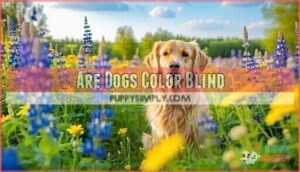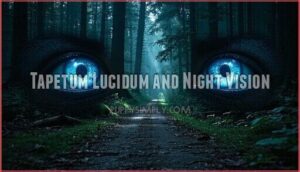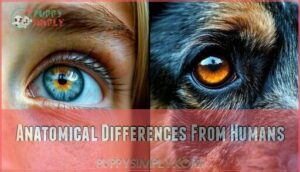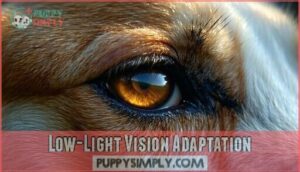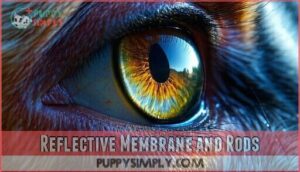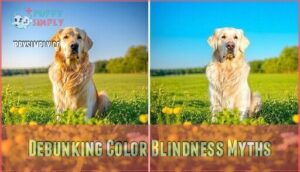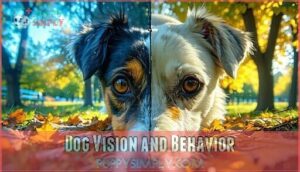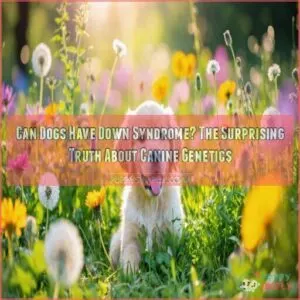This site is supported by our readers. We may earn a commission, at no cost to you, if you purchase through links.
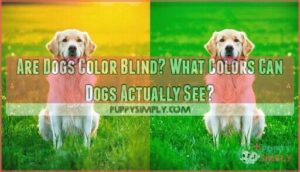 Dogs aren’t completely color blind, but they don’t see the rainbow like you do.
Dogs aren’t completely color blind, but they don’t see the rainbow like you do.
While you’ve got three types of color-detecting cones in your eyes, your furry companion only has two.
This means dogs experience dichromatic vision—similar to humans with red-green color blindness.
Your dog’s world consists mainly of blues, yellows, and various shades of gray and brown.
Red appears brownish-yellow to them, while green looks yellowish.
So that bright red ball you threw? It’s practically invisible against green grass.
Understanding your dog’s unique visual world opens up fascinating insights about choosing the right toys, training tools, and even understanding their behavior in ways you never imagined.
This knowledge can help you make better decisions to support your dog’s visual world and overall well-being, leading to a more harmonious and enriching experience for both you and your pet, and creating a stronger bond through better understanding.
Table Of Contents
- Key Takeaways
- Dog Color Vision Basics
- Are Dogs Color Blind
- Colors Dogs Can See
- Dog Eye Structure Explained
- Night Vision in Dogs
- Practical Implications for Owners
- Debunking Color Blindness Myths
- Dog Vision and Behavior
- Frequently Asked Questions (FAQs)
- What is the easiest color for a dog to see?
- What is the hardest color a dog can see?
- What colors can dogs see in grass?
- How does a dog see a tennis ball?
- Do all dog breeds see colors differently?
- Can dogs see TV screens and colors clearly?
- How does age affect dog color vision?
- Do puppies see colors like adult dogs?
- Can colorblind dogs be trained for service work?
- Conclusion
Key Takeaways
- Your dog isn’t completely colorblind – they have dichromatic vision similar to humans with red-green color blindness, seeing about 10,000 colors compared to your million-color spectrum.
- Dogs see blues and yellows best – their two-cone vision system makes blue and yellow toys stand out clearly, while red appears brownish and green looks yellowish or gray.
- Red toys are practically invisible – that bright red ball you’re throwing disappears against green grass because your dog can’t distinguish red from the background.
- Choose blue and yellow for better visibility – selecting toys and training tools in these colors will dramatically improve your dog’s ability to see and interact with them during play and training.
Dog Color Vision Basics
You’ve probably wondered if your dog sees the world in black and white, but that’s actually a myth.
Dogs aren’t completely colorblind—they have dichromatic vision, meaning they see colors differently than humans who’ve trichromatic vision with three types of color-detecting cone cells.
Dog Vision Compared to Humans
Your dog’s visual world operates like a simplified version of yours.
While you possess trichromatic vision with three types of color-detecting cones, your dog has dichromatic vision with only two cone types.
This cone difference means dogs see approximately 10,000 colors compared to your million-color spectrum.
Their visual acuity measures around 20/75 versus your sharp 20/20, but these evolutionary advantages prioritize motion detection over color perception.
Types of Color-Detecting Cones
Your eyes contain three types of cone cells that detect red, green, and blue light – this is called trichromatic vision.
Dogs have dichromatic vision with only two cone types: one sensitive to blue wavelengths and another to yellow-green.
These photopigment types create different cone sensitivity patterns. While you can distinguish millions of colors through cone distribution across your retina, dogs see a more limited spectrum.
This dichromatic setup means dog color perception works differently than yours.
Colors Perceived by Dogs
Through dichromatic vision, your dog perceives a limited visual spectrum dominated by blue and yellow hues.
Canine colorimetry reveals dogs see blue distinctly while yellow appears vibrant in their color range.
These dominant hues create their entire perceived shades palette.
Red and green blend into muddy browns or grays, making dog color perception fundamentally different from human trichromatic vision.
Are Dogs Color Blind
Understanding color perception in dogs requires examining scientific evidence about their dichromatic vision.
Dogs aren’t completely color blind—they can see color, just differently than humans.
Their canine spectrum includes blues and yellows, while red and green present visual limitations.
Dogs see blue distinctly and perceive yellow clearly, but these two color types comprise their entire visual range.
Scientific evidence confirms dogs experience dichromatic vision, similar to humans with red-green color blindness, debunking myths about total dog color blindness, which is based on their ability to see blues and yellows, and their limitation with red and green.
Colors Dogs Can See
Your dog’s world isn’t black and white, but it’s not as colorful as yours either.
Dogs see a limited spectrum dominated by blues and yellows, similar to humans with red-green color blindness.
Blue and Yellow Color Spectrum
Your canine companion’s color perception operates like a specialized filter, highlighting blues and yellows with remarkable clarity.
Blue dominance in dog color vision means they distinguish blue variations exceptionally well, from navy to sky blue.
Yellow and blue dominance creates superior spectrum visibility through enhanced color contrast, making blue and yellow combinations stand out dramatically against their environment, as dogs see these hues most vividly.
Perception of Red and Green
Your dog’s perception of red and green reveals fascinating limitations in canine vision.
Red objects appear as dark brown or blackish tones, while green registers as muted yellow or gray.
This color confusion affects 92% of dogs, making red-green combinations appear as indistinguishable muddy tones.
Understanding these perception challenges helps explain why your dog might struggle with toy visibility and training impact when red or green items blend into their surroundings.
Color Combinations Visible to Dogs
Blue-yellow contrast creates the strongest visual distinction for your dog’s dichromatic vision system.
While color confusion affects red-green perception, strategic color combinations enhance toy visibility and training effectiveness. Your dog processes visible gradients within their limited spectrum, making specific pairings essential for canine color vision optimization.
Here are four effective color combinations dogs see best:
- Bright blue toys against yellow backgrounds – maximizes contrast for fetch games
- Yellow training equipment on blue surfaces – helps dogs distinguish training colors clearly
- Blue and white combinations – creates sharp definition dogs can easily identify
- Yellow markers with neutral backgrounds – prevents color confusion during activities
Dog Eye Structure Explained
To understand why dogs see the world differently than you do, you’ll need to examine the unique structure of their eyes.
The canine retina contains specialized cells called rods and cones that determine what colors they can perceive and how well they navigate in darkness.
Rods and Cones in Canine Retina
Your dog’s retina contains millions of photoreceptor cells with distinct roles.
Millions of specialized cells work together to create your dog’s unique visual experience.
Rods dominate with approximately 20 times more cells than cones, creating exceptional rod sensitivity for motion detection and retinal adaptation to dim lighting.
This cellular density arrangement prioritizes night vision over color perception.
Photoreceptor function varies substantially—rods handle grayscale detection while cone distribution focuses on blue-yellow wavelengths, fundamentally shaping canine vision capabilities compared to human eye receptors, which highlights the importance of retinal adaptation.
Tapetum Lucidum and Night Vision
Looking beyond the traditional lens of canine vision, the tapetum lucidum acts as your dog’s built-in flashlight.
This reflective membrane behind the retina bounces light back through photoreceptors, enhancing sensitivity in low-light conditions.
Through evolutionary advantages, this nocturnal adaptation gives dogs superior night vision compared to humans.
The tapetum function explains why dog vision excels in darkness, supporting their crepuscular hunting heritage despite dog color blindness limitations.
Anatomical Differences From Humans
How dramatically do your dog’s eyes differ from yours in terms of processing visual information?
The anatomical variations between human and canine eyes create fundamentally different visual experiences through specialized structural adaptations.
- Retina Composition: Dogs possess rod-dominated retinas with fewer color-sensing receptors, prioritizing motion detection over detailed color discrimination
- Pupil Size: Larger canine pupils capture more available light, enhancing low-light performance compared to human eye capabilities
- Lens Variation: Dog eye anatomy features broader corneal surfaces and enhanced light-gathering capacity for superior night vision
- Field of View: Eye placement provides dogs with wider peripheral vision ranges, supporting their evolutionary hunting and survival instincts
Human eyes: Monday, June 30, 2025.
Night Vision in Dogs
Your dog’s exceptional night vision stems from evolutionary adaptations that far surpass human capabilities in low-light conditions.
Your dog’s eyes are built like natural night-vision goggles, turning darkness into their playground.
The canine eye contains specialized structures including a higher concentration of rod cells and a reflective membrane called the tapetum lucidum that amplifies available light for superior nocturnal navigation, utilizing its exceptional night vision capabilities.
Low-Light Vision Adaptation
Your dog’s eyes evolved from those nocturnal hunting ancestors, creating remarkable low-light adaptations.
Rod density in canine retinas substantially exceeds human levels, while larger pupil size allows maximum light entry. This enhanced night vision supports motion detection capabilities that once aided survival.
| Adaptation Feature | Canine Specification | Human Comparison |
|---|---|---|
| Rod Density | 95% of retinal cells | 75% of retinal cells |
| Pupil Size | Larger diameter opening | Smaller light aperture |
| Motion Detection | Enhanced sensitivity |
Standard sensitivity.
The tapetum lucidum acts like nature’s night-vision goggles, reflecting available light back through the retina for a second chance at photon capture. This reflective layer, combined with abundant rods and cones optimized for dim conditions, transforms your pet into a capable low-light navigator.
Reflective Membrane and Rods
Your dog’s exceptional night vision stems from two key anatomical features that work together like a biological night-vision system.
The tapetum lucidum acts as a reflective mirror behind the retina, bouncing light back through photoreceptors for a second chance at detection.
Here’s how these structures enhance your dog’s Low-Light Adaptation:
- Rod Density – Your dog’s retina contains substantially more rods than yours, with these cells being 100 times more sensitive to light than human rods
- Tapetum Function – This reflective membrane increases available light by up to 40%, giving that characteristic eye glow you’ve noticed
- Enhanced Motion detection occurs because rods excel at tracking movement in dim conditions, supporting ancestral Night Hunting behaviors
- Light amplification happens when photons pass through the retina twice, maximizing each available light particle for improved dog eyesight
This combination of increased rod concentration and the tapetum lucidum’s reflective properties creates a sophisticated system that transforms your pet into an efficient low-light navigator, far surpassing human capabilities in darkness.
Improved Navigation and Hunting
Enhanced night vision capabilities provide your dog with significant evolutionary advantages for navigation and hunting activities.
Their rod-packed retinas and tapetum lucidum create superior prey detection abilities in low-light conditions.
This environmental adaptation allows dogs to track movement and identify potential targets during dawn and dusk hours when many prey species are most active.
These sensory compensation mechanisms overcome color vision limitations, making hunting strategies more effective despite restricted dog color vision and dog eyesight challenges affecting their ability to see.
Practical Implications for Owners
Understanding your dog’s unique color vision helps you make better choices for their daily life.
You’ll discover how selecting the right colors for toys and training tools can substantially improve your pet’s ability to see and interact with their environment, which is crucial for their overall well-being and daily life.
Choosing Toys and Training Tools
Understanding your dog’s dichromatic vision transforms how you’ll select training equipment and toys.
Strategic choices enhance visual cue effectiveness and boost engagement during play sessions.
When choosing training tools and toys based on dog color vision, consider these evidence-based recommendations:
- Toy color visibility optimization – Select blue and yellow items that stand out against various backgrounds, improving your dog’s ability to track and retrieve objects during fetch games.
- Training tool contrast enhancement – Use color-coded commands with high-contrast blue or yellow markers for agility courses, creating clear visual distinctions your dog can reliably identify.
- Breed-specific preferences consideration – While all dogs see yellow and blue best, individual dogs may show preferences within this spectrum based on learned associations and environmental factors.
Smart toy selection isn’t just about aesthetics – it’s about working with your dog’s natural visual capabilities to create more successful training outcomes.
Many owners specifically look for durable blue playthings to cater to their dog’s vision.
Avoiding Red and Orange Colors
Red and orange toys create significant color confusion for dogs due to their dichromatic vision, similar to red-green color blindness in humans.
These colors appear as dark brown or muddy yellow, making toy visibility poor during outdoor play.
Red toys blend seamlessly with green grass, reducing training impact and engagement, which is a problem because all dogs struggle with red color perception.
While breed differences exist in visual acuity, all dogs struggle with red color perception, making these poor choices for effective play sessions.
Using Blue and Yellow for Visibility
Blue and yellow toys maximize visual contrast for dogs with dichromatic vision.
Training visibility improves dramatically when you select blue or yellow equipment instead of red alternatives.
Outdoor safety benefits from choosing high-contrast colors that dogs can distinguish easily.
Home enrichment involves strategically placing blue and yellow accents around food bowls and play areas.
This visual contrast optimization helps dogs navigate their environment more effectively, supporting their natural blue-yellow color blindness adaptation.
For added safety during walks, consider a reflective dog collar, which can improve outdoor safety and provide visual contrast with high-contrast colors.
Debunking Color Blindness Myths
You’ve probably heard that dogs are completely colorblind, but that’s one of the biggest myths about canine vision.
While dogs don’t see the full rainbow like humans do, they’re not stuck in a black-and-white world either.
Common Misconceptions About Dog Vision
Despite widespread belief in the Black/White Myth, dogs aren’t completely colorblind.
They possess dichromatic vision with Limited Spectrum perception, seeing blues and yellows clearly.
Their Visual Acuity differs from humans, emphasizing Motion Perception over fine detail.
While Breed Differences exist in eye structure, all dogs share similar color vision capabilities.
Understanding dog color perception facts helps debunk the misconception that canines see only grayscale—they experience a vibrant, albeit restricted, color world.
Certain breeds, like French Bulldogs, may exhibit unique genetic traits influencing their appearance, such as the rare blue eyes.
Spectrum Challenges in Dogs
Your dog’s visual spectrum presents unique Color Discrimination challenges that differ substantially from human perception.
Canine Color Vision operates with limited Wavelength Sensitivity, creating Color Deficiencies in red-green detection.
Their Visual Acuity focuses on blue-yellow ranges, while Light Adaptation mechanisms prioritize motion over detailed color recognition.
Understanding these spectrum limitations helps explain why your dog struggles with certain environmental cues.
Busting Myths With Science
Scientific evidence definitively refutes persistent vision misconceptions about canine sight.
Color vision research utilizing electroretinography and behavioral studies demonstrates dogs possess dichromatic visual spectrum capabilities, not monochromatic perception.
These findings challenge outdated beliefs through rigorous scientific debunking methods.
5 Research-Backed Facts That’ll Change How You See Dog Vision:
- Electroretinography reveals two distinct photopic peaks – proving dogs detect blue-yellow wavelengths, not just grayscale
- Behavioral reward studies show 80% accuracy – when dogs distinguish between blue and yellow training tools
- fMRI scans demonstrate heightened brain activity – specifically responding to blue-yellow color contrasts versus red-green
- Cone cell analysis identifies two photopigment types – similar to human red-green color blindness patterns
- Genetic sequencing confirms opsin proteins – matching dichromatic mammals, not monochromatic species
Dog Vision and Behavior
Understanding your dog’s visual limitations helps you better interpret their behavior and meet their specific needs.
While dogs can’t see the full color spectrum you do, they’ve developed enhanced smell and hearing abilities that more than compensate for these visual restrictions, which is a key factor in their overall behavior and interaction with their environment, including their specific needs.
Compensating With Smell and Hearing
Your dog’s remarkable sensory prioritization means they rely heavily on their sense of smell and hearing when visual information falls short.
With olfactory acuity that’s 10,000 times stronger than yours and an auditory range extending to 65,000 Hz, dogs navigate their environment through sensory dominance that far exceeds human capabilities.
This environmental navigation system allows breed differences in visual and olfactory senses to complement each other seamlessly.
Interpreting Behavior and Meeting Needs
Understanding your dog’s visual limitations transforms how you interpret their behavior and meet their needs effectively.
When your pup seems disinterested in that bright red ball, it’s likely a visibility issue rather than lack of enthusiasm.
Recognizing these sensory compensation patterns helps reduce frustration:
- Difficulty locating toys may indicate poor color contrast rather than disobedience
- Hesitation during training could stem from inability to distinguish visual cues
- Preference for certain objects often reflects ideal dog color vision wavelengths.
This knowledge enhances dog training success and toy visibility while supporting better dog behavior understanding.
Addressing these issues can help prevent common dog behaviour.
Importance of Ethical Breeding and Environment
Ethical breeding practices directly impact canine color vision development and overall behavioral outcomes.
Genetic Health screening reduces hereditary disorders by 40-60%, while proper Environmental Enrichment during critical socialization periods enhances visual processing abilities.
Responsible Ownership includes understanding how dog color vision differs from human vision, affecting Temperament Concerns and behavior interpretation.
Quality breeding environments support ideal neurological development, strengthening the connection between canine color vision and adaptive responses.
Finding responsible dog breeders is essential for these reasons, as it ensures Ethical breeding practices and promotes Responsible Ownership, which are crucial for the development of canine color vision and the reduction of hereditary disorders.
Frequently Asked Questions (FAQs)
What is the easiest color for a dog to see?
Like a lighthouse cutting through fog, blue shines brightest in your dog’s visual world.
Your pup’s dichromatic vision sees blue wavelengths most clearly, making blue toys and training tools the easiest to spot during play.
What is the hardest color a dog can see?
Red sits at the top of your dog’s "hardest to see" list.
Their dichromatic vision transforms red objects into muddy browns or dark grays, making them nearly invisible against green grass or brown surfaces.
What colors can dogs see in grass?
Through tall green blades, dogs navigate their world differently—yellow sunlight dances while blues peek through, but greens fade into muddy yellows, making contrast detection challenging in grassy environments.
How does a dog see a tennis ball?
Your dog’s dichromatic vision transforms that bright yellow tennis ball into a vivid standout against green grass.
While you see vibrant yellow-green contrast, they perceive bold yellow against muted beige background, making retrieval easier than red toys, due to the vivid standout.
Do all dog breeds see colors differently?
Contrary to medieval beliefs about canine sight, all dog breeds share identical dichromatic vision. You’ll find every breed sees the same blue-yellow spectrum, lacking red-green perception like colorblind humans.
Can dogs see TV screens and colors clearly?
Dogs can see TV screens, but colors appear muted compared to human vision.
They’ll perceive blues and yellows clearly while reds and greens look brownish or grayish through their dichromatic vision system.
How does age affect dog color vision?
Age-related changes don’t affect your dog’s inherent dichromatic color vision.
However, senior dogs may experience changes in depth perception, worsening vision, poor night vision, and lens cloudiness from nuclear sclerosis can develop, which may mute their blue-yellow color spectrum slightly.
Providing night lights can assist senior dogs with low-light vision.
Do puppies see colors like adult dogs?
Like tiny windows opening to a colorful world, puppy eyes develop their dichromatic vision gradually.
You’ll notice puppies can’t distinguish colors until around eight weeks old, when their cone cells mature to see blue-yellow spectrums like adult dogs.
Can colorblind dogs be trained for service work?
You’ll find that service dogs with dichromatic vision excel in their training and duties.
Their blue-yellow color perception doesn’t hinder their ability to navigate, detect medical emergencies, or guide visually impaired handlers effectively.
Conclusion
Studies show that 8% of men experience red-green color blindness, similar to your dog’s dichromatic vision.
Understanding are dogs color blind and what colors can they see helps you make smarter choices for your pet.
Your dog’s blue-yellow color spectrum means they’ll spot that bright blue frisbee better than a red one.
While they can’t see the full rainbow you do, dogs compensate brilliantly with superior night vision and enhanced smell.
Choose toys wisely, and you’ll enhance their world substantially.
- https://www.ncbi.nlm.nih.gov/pmc/articles/PMC8388720/
- https://nei.nih.gov/health/color_blindness/facts_about
- https://www.aoa.org/patients-and-public/eye-and-vision-problems/glossary-of-eye-and-vision-conditions/color-deficiency
- http://www.yorku.ca/eye/trichrom.htm
- https://vcahospitals.com/know-your-pet/cataracts-in-dogs

